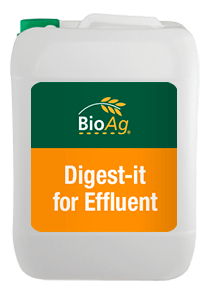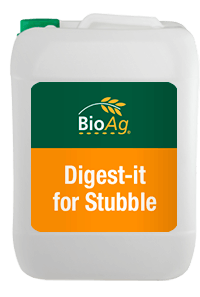Digesters
BioAg digesters are formulated to feed and promote microbes that result in the aerobic breakdown of organic matter.
Aerobic digestion is the breakdown of organic matter in the air in the presence of oxygen. The proprietary BioAg portfolio includes an effluent (manure or animal waste) digester and a stubble (plant residue) digester. Both are Australian Organic Registered Farm Input products (allowed input 221).
Plant residue or animal waste primarily consists of organic carbon, typically present as cellulose or carbohydrates. They will also contain a range of macro and micronutrients, including nitrogen, phosphorus, potassium, and sulphur. The amount of macronutrients in the residue will depend on the source of the waste, e.g., animal manures are typically higher in nitrogen, while sugar cane waste is high in potassium.
BioAg’s Digest-it is also exported to and widely used in Ireland, the United Kingdom and South Korea.
More information
Anaerobic digestion, without air, will typically break down carbon to smaller chain hydrocarbons and methane, nitrogen to ammonia, sulphur to hydrogen sulphide (rotten egg gas), and the resultant solid residue, digestate, will be high in Biological Oxygen Demand (BOD). Methane, ammonia, and hydrogen sulphide are all gases and will comprise BioGas, which is desirable if you can capture the gases and burn them through a BioGas plant to produce power. The burnt gases containing nitrogen, sulphur, and carbon, are then sent to the atmosphere.
Aerobic digestion with air, also referred to as composting, breaks down carbon to smaller chain hydrocarbons, humates or carbon dioxide, nitrogen to nitrate salts and sulphur to sulphate salts. The solid residue, digestate, has a lower BOD.
As nitrogen and sulphur are retained in the digestate of aerobically digested waste, the same waste will produce a digestate of higher nutrient (fertiliser) value when treated through anaerobic digester.
Aerobic digestion can also reduce odours (not producing ammonia or hydrogen sulphide) and provides greater microbial competition plus an unfavourable environment for pathogens.
Aerobic digestion is often cited as being more costly due to the need for agitation and aeration through pumping. BioAg trials have shown that a well-activated pond will agitate itself, and in addition, more of the digestate will remain in solution, reducing the frequency of digging out ponds and dams and having to treat or dispose of sludge.
 Benefits of aerobic digestion
Benefits of aerobic digestion
- Lower cost of setup – no enclosed tanks or gas capture
- Greater retention of valuable nutrients
- Lower BOD of digestates
- Shorter withholding periods when applying digestates to soils
- Reduced levels of ammonia and hydrogen sulphide gases.
Product Range

Digest-it for Effluent
Digester
Formulated to improve the breakdown of solids and the retention of nutrients in captured animal effluent. Provides a range of food sources and metabolites that promote aerobic digestion in effluent streams.

Digest-it for Stubble
Digester
Formulated to accelerate the microbial breakdown of cellulose and other plant matter. Digests stubbles, residues, and other organic wastes into humus. Ideal for use as a compost starter.

Committed to organics
With a core range of natural fertilisers and biostimulants, BioAg can offer an extensive range of products certified by Australian Organics, suitable for use in organic systems.
